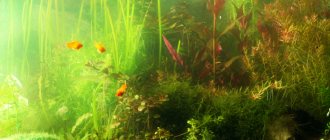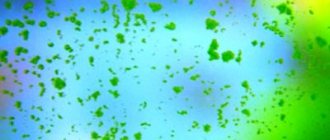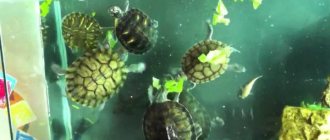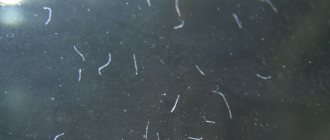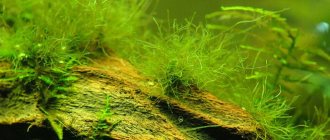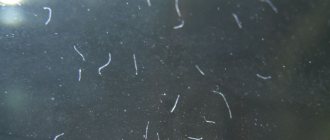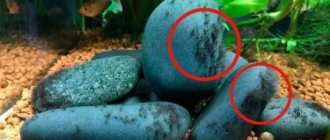Causes of mold in an aquarium
Mold in an aquarium can appear for several reasons, and all of them are associated with improper operating conditions of the device.
The main reasons include:
- High humidity on the surface of the aquarium lid. This is where the fungal infection is usually localized.
- Insufficient, and often completely absent, ventilation system.
- Insufficient aquarium care. Rarely wash it and change the water.
- Storing the device indoors, which has extensive mold growth.
- Storing the device indoors with poor ventilation. In a damp room.
Mold can lead to the death of all aquarium inhabitants, but mold is especially harmful to plants
As a rule, there is not one, but several reasons at once that lead to such a problem. Most often, this is due to a violation of ventilation + the rules of operation of the aquarium + high humidity on the lid of the device.
Why is this dangerous?
The biggest and most obvious danger is the death of the aquarium inhabitants. Ordinary household mold is dangerous even for humans, and let’s not even talk about fish or shellfish. At best, the inhabitants of the aquarium will “get off” with non-fatal health problems.
There is also a danger of rotting of the device itself; the lid of the aquarium wears out especially quickly. If the mold is deeply embedded, it will not be possible to remove it completely. You will either have to replace the parts of the aquarium, or even purchase a new one.
What it is?
The green coating is a colony of algae. The most common of them are protococcus (Chlorococcum), “green dust” (Green dust algae), and xenococcus (Choleochaete orbicularis). The first forms a coating only on the inside of the glass, the second - on the glass and the surface of the water, and the third - on the glass and leaves of aquarium plants.
Reference . The name “green dust” is taken not from the scientific lexicon, but from the jargon of aquarists. There is no exact data on which types of algae form such a coating.
Algae are part of the natural microflora of the aquatic environment and are always present in it . Problems appear when normal conditions are violated - algae begin to multiply too actively. More precisely, they form spores. Typically, single-celled plants reproduce by division, and this happens slowly. If the natural balance is disturbed, then one cell forms up to 32 spores, and from each a new organism appears. Reproduction is rapid in nature.
Is it dangerous?
Protococcus and “green dust” are not dangerous for fish , aquatic plants and other inhabitants of the aquarium, but they spoil the appearance of the living area. Xenococcus, which is deposited not only on the walls and surface of the water, but also on the leaves, causes harm to aquarium plants.
How to remove mold from an aquarium? (+video)
To destroy mold in an aquarium, you can use several methods, which are fundamentally different from each other. The most preferable is a combination of household chemicals or folk remedies, but first, for safety reasons, it is better to use simply folk methods.
Traditional methods are not as effective as chemicals, but they are not as harmful to people and aquarium inhabitants. In addition, they are simple and cheap to implement and most often involve the use of household products available in any home.
If traditional methods are ineffective, you can safely use household chemicals, but preferably after consultation with specialists. You can select chemical products in aquarium stores, after getting advice from the seller.
It is best to use specialized anti-mold products designed specifically for treating aquariums. They are somewhat more expensive than general products, but they will not harm the structure of the product and will remove mold more effectively.
Household chemicals
The most preferred remedy is Tatra algizit. This is a specialized product for eliminating stubborn algae/mold from an aquarium. The product is intended specifically for such purposes and after its use it creates passive protection against re-infection with the fungus for 2-3 months.
Tatra algizite is absolutely safe for aquarium inhabitants. It's quite simple to use:
- We place the drug in the stones or soil of the aquarium, preferably away from plants, at the rate of 1 Tatra tablet per 20 liters of water.
- We ensure optimal aeration and water circulation.
- We repeat the Tatra treatment procedure after 3-4 weeks ( optional, only if necessary ).
The antibiotic method is very effective. Penicillin, Erythromycin, Streptomycin and Bicillin are suitable against mold. But first we need to determine the degree of sensitivity of the fungus to antibiotics, for which we carry out simple preparation:
- We take a Petri dish, you can buy it at the pharmacy.
- We remove the film of mold from the surface of the water in the aquarium (usually it has a bluish-greenish tint).
- Place the film in a Petri dish.
- Dissolve each type of antibiotic separately in a container of water.
- We soak a piece of filter paper in prepared solutions with antibiotics.
- A piece of paper needs to be laid out on the surface of the fungal film.
- The Petri dish should be dry (no water), but there should be moderate humidity.
- Place the Petri dish in a dimly lit room, keeping the temperature at 24-28 degrees. We leave it for 2 days.
- We take out a Petri dish and examine under the influence of what type of antibiotic the fungus began to dissolve on the filter paper.
- We use the most effective antibiotic in the form of a solution to treat the aquarium, for which we treat areas of fungal infection with it.
Folk remedies
The best methods for removing mold are hydrogen peroxide, bleach and glutaraldehyde, also known as Sidex. The easiest way is to use white, for which you need to dilute it in water in a concentration of 1 to 30 and moisten the areas of fungal infection with the prepared concentrate.
Common diseases
A white coating on fish in an aquarium is a symptom of a disease and requires medical attention. The main thing is to correctly identify the disease itself, and only then begin treatment. Only with correct diagnosis can you count on successfully saving your aquarium fish from the disease.
Beginners in the field of aquarium keeping often confuse white coating with clouding of the fish’s color, which leads to fatal mistakes. Cloudy bodies are usually a sign of poor water quality and do not require serious treatment. For example, the color scheme of a fish sometimes fades due to inflammation of the gastrointestinal tract - in this case, the sick individual is not given food for a week, and then is switched to a varied diet.
A white coating on a fish in an aquarium can be a symptom of various diseases that can be encountered by both professionals and novice aquarists. It should be understood that most diseases are contagious, regardless of the type of sick individual. For example, the appearance of a white coating on a goldfish does not guarantee that other species of fish will not suffer from the same disease.
Dermatomycosis
Ringworm is a common disease of aquarium fish that occurs due to low water temperatures in the tank. If an incorrect diet, high acidity and a high content of organic residues are added to cool water, the course of the disease will worsen and can cause another serious illness - saprolegniosis.
The initial stage begins with the body of the fish becoming covered with a white or light yellow coating, similar to moss. If medical measures are not taken at this time, the disease begins to progress: the white growth transforms into thread-like tentacles, then ulcers and cracks appear on the body of the sick pet.
Treatment of the affected individual begins immediately. The first step is to prepare a separate tank, into which the sick fish covered with a white coating are moved, and the healing process begins:
- the water temperature is increased to 26C;
- a pre-prepared solution with bicillin-5 is poured into the aquarium (50,000 units per 10 liters);
- The tank lighting is dimmed;
- The procedure is repeated from 4 to 7 days.
Bicillin-5 is the most popular medication for the treatment of dermatomycosis, but not the only one. If it is not possible to use bicillin-5, you can use malachite green or copper sulfate. To avoid relapse, all decorations and plants are treated with special solutions or preparations.
Gyrodactylosis
Gyrodactylosis is a disease caused by hylodactylus flukes. Most often they parasitize on the body and fins of fish, less often on the gills. Individuals infected with gyrodactylosis are covered with white or gray-blue mucus, which is clearly visible if the fish turns its head towards the owner. The disease is also accompanied by the following symptoms:
- the pet stops swimming, or moves jerkily, while pressing its fins to its body;
- the fish begins to rub against the walls and decorations;
- the fins are divided into rays;
- Sores appear on the pet's body.
If treatment is not started in time, sick fish die due to oxygen depletion.
Copper sulfate is used to get rid of gyrodactylosis. First, the infected fish is placed in a separate tank, and a solution is added there (15 g of copper sulfate per 10 l). The course of treatment lasts one week. To prevent gyrodactylosis from spreading to other inhabitants of the reservoir, the aquarium should be treated with salt.
Trichodinosis
Trichodinosis is another disease, the classic sign of which is a white coating on the fins and body. The causative agent of the disease is the ciliate ciliate. Trichodinosis is usually caused by dirty water, decorative materials and poor food. In the initial stages, trichodinosis is difficult to notice; the only sign of an incipient disease is unusual behavior: infected fish gather near aerators.
The subsequent stage of trichodinosis is accompanied by the appearance of white growths, which over time come off like flakes. Mucus appears on the gills of infected fish, and breathing becomes intermittent.
You can cure sick pets using a quarantine aquarium. The water temperature should be 30C, and the reservoir is also equipped with powerful aerators. Table salt (15 g per 10 l) is introduced into the tank to completely destroy the disease.
Costiosis
Costiosis is a serious disease that, if left untreated, leads to death. The causative agent is a flagellate. The first signs of costosis can be determined by the behavior of the fish - the pet refuses to eat, clamps down, tries to be closer to fragments of decor or walls.
As soon as the parasites are completely established in the body, spots and growths of a gray-white hue appear on the fish, and the gills become covered with mucus. This prevents the supply of oxygen, and the affected individual dies.
The causes of costosis may be:
- sick fish recently added to the pond;
- soil infested with parasites;
- poor quality food.
Methyl blue, quarantine tanks and table salt are used to treat costiosis. In a community aquarium, the water temperature is increased to 32–34C to kill flagellates.
When relocating sick individuals into separate tanks, experienced aquarists carry out additional treatment: potassium permanganate (0.1 g per 10 l) is poured into the water. To prepare the solution, regular table salt is also used. In this case, extreme caution should be exercised, since prolonged exposure of ornamental fish to such water can cause deterioration in health.
Ichthyophthiriasis
Ichthyophthyriosis is a common disease of aquarium fish caused by ciliates. Popularly also often referred to as “semolina” or “spot disease”. Characteristic signs: the fish become covered with white bumps or dots, tremble, and lose their appetite.
Ichthyophthiriasis affects internal organs, scales, and gills. The disease is not considered dangerous, but if no treatment is taken, the fish may die. The causes and treatment of semolina in aquarium fish may vary. It is better to study the features of this disease in theory in advance.
Interesting fact: individuals who have recovered from semolina gain immunity and never suffer from ichthyophthyriosis again.
To treat spot disease, bicillin-5, malachite green and antipar are used. You should also update the water regularly (every four days) and increase the water temperature by 5 degrees.
Columnaria
Columnaria is a disease caused by bacteria. The second name of the disease is oral fungus. The main reasons for the development of columnarium are considered to be overpopulation of the reservoir, lack of oxygen and pollution of the aquarium.
Symptoms of the disease:
- fins shrink, movements become jerky;
- the pet loses mobility and often remains in one place;
- Swimming up to the surface of the water surface, the fish jerkily inhales air.
Columnaria develops slowly and is accompanied by a white coating. First, growths appear in the mouth, then move to the head, abdomen and fins. There have been cases when a white film appeared before the eyes of pets.
Experienced aquarists recommend treating sick fish using baths with methyl blue and table salt (1 tbsp per 20 l). Antibiotics may be used.
To prevent the risk of developing the above diseases, you should carefully monitor the condition of the inhabitants in the aquarium and follow the rules of care. If the fish is covered with a white coating, this is a clear sign of deterioration in its health. In this case, correct identification of the disease and timely treatment are guaranteed to save the pet’s life.
Prevention of occurrence
Proper care and operation of the device can prevent the appearance of fungus in it. It's not as difficult as it might seem, you just need to follow a few preventive measures:
- store the device in a well-ventilated area;
- do not allow the device to remain in a damp or moldy room for a long time;
- change the water regularly and rinse the aquarium inside and out;
- do not allow excess moisture to accumulate on the device cover;
- periodically carefully inspect the device and, when the first signs of fungal infection appear, destroy it using the previously listed traditional methods.
The listed methods of prevention do not guarantee 100% protection against the appearance of fungus, but the chances are significantly reduced. You can find out specific tips for caring for your aquarium from the information booklet that comes with it in the packaging when you purchase it.
Share on social media networks:
Black mold has appeared in the aquarium - our specialists, who have prepared a list of tips for solving this problem, will tell you how to deal with it.
How to clean glass and decorations?
The white coating in the aquarium will disappear when the biological balance is restored.
The following steps will help speed up this process:
- Clean the aquarium from rotting organic matter (residues of plants and food).
- What to wash with? You can rinse the aquarium filter sponges without any preparations with plain water.
- Wash dirt from the filter with running water at room temperature.
- As an option: install a filter with a large volume of filter material or a filter that makes it possible to use sorbents (for example, activated carbon).
- Replace 15–20% of the water in the tank with settled water at aquarium temperature.
- Eliminate overcrowding of the aquarium.
- As an option: add nurse fish (for example, ancistrus) to the tank.
- Adjust the fish feeding scheme, consider switching to another, higher quality food.
HOW TO DETERMINE AMMONIA IN AN AQUARIUM AND HOW TO DEAL WITH IT?
HYDRA IN THE AQUARIUM: DESCRIPTION, DISPOSAL, PHOTO, VIDEO
FLIPPER IN THE AQUARIUM: DESCRIPTION, RIDING, SYMPTOMS, PHOTO, VIDEO
How to deal with mold in an aquarium?
The following methods are available to remove black mold:
- Mechanical - performed by cleaning with a sponge, scraper, blade or toothbrush. This solution is good because it protects the walls of the aquarium and the plants in it from the appearance of black mold on them, and also contributes to the regular loosening of the soil.
- Biological - breeding gastropods that actively consume algae. But, unfortunately, the growth of algae exceeds their consumption by the inhabitants who live in it.
- Biochemical - used after cleaning the aquarium, by dissolving antibiotics or antiseptics in it.
Important! To achieve the best quality result, use not one method, but a combination of several.
How to get rid of diatoms in an aquarium
If brown or brown spots appear in a new body of water, it is enough to wait a few weeks. During this time, a biological balance will be established and the exchange of nitrogen compounds will be normalized.
In an old aquarium, the following methods are used:
- Weekly cleaning of soil from dirt, regular filtration of water.
- Frequent water changes. Up to a third of the total volume is changed every 5-7 days.
- Normalization of daylight hours. LED or red-spectrum fluorescent lamps help cope well.
- Reducing the amount of fish food and plant fertilizers.
- Increasing the number of higher plants in the reservoir. They begin to compete with unicellular organisms and absorb all the nutrients, depriving the diatoms of the opportunity to grow. Caulepra or mangrove species cope well with this. Affected plants are removed completely or partially depending on the degree of infection.
- Maintaining temperature in the range of +18…+22°C.
- Control of hardness and acidity indicators, levels of silicates and nitrogenous compounds.
- You can put a piece of copper or zinc at the bottom of the tank. However, not all fish tolerate the presence of these metals well.
- Take out the soil and boil it or calcinate it at a temperature of +300°C.
A preparation for diatoms.
When changing the water, stones, decorative items, glass and algae leaves are cleaned. This can be done using a sponge or brush moistened with a weak solution of manganese. Brown plaque is easily removed from surfaces. Only after mechanical cleaning the water is changed. The fish are first transplanted into another previously prepared reservoir.
Brown algae can be removed using chemical compounds. They enhance the growth of higher aquarium plants and inhibit the growth of microorganisms. However, they must be handled carefully so as not to upset the balance of the biological environment and not cause the death of the entire aquarium. The drugs “Tetra Algetten”, “Tetra Bactozyme”, “Algol”, etc. are used.
Dimming method
Another quite effective method, which is more of a combined technique. The stages of the procedure also include the use of several of the means indicated above, which allows you to obtain the highest quality and fastest results.
Black mold has appeared in the aquarium - find out how to deal with it using the darkening method in this instruction:
- Take a dark, thick fabric.
- Clean the aquarium mechanically as much as possible.
- Clean the filter.
- Replace water by 50%.
- Eliminate the CO2 supply, turn on the aeration, turn off the lights.
- Provide water circulation.
- Darken the aquarium with a cloth.
- Add hydrogen peroxide to the water - no more than 15 mg/l of water.
- Replace the water by 50% the next day and add hydrogen peroxide again.
- The next day, repeat the procedure.
- Turn on the lights on the fourth day.
- Collect the mold using a net.
- Begin gradually introducing oxygen into the aquarium over several days.
- Add nitrogen or phosphorus - this will help restore the strength of useful and necessary plants.
Important! The darkening method does not affect the fish or harm them in any way.
Mudiness, rot, green water is something every aquarist has encountered. Such manifestations indicate that the biobalance in a small body of water is disturbed. How to help its inhabitants and clean up their habitat? What to do if you suddenly find mold in your aquarium?
Mold likes to appear in the aquarium if the water is changed insufficiently often.
Brown plaque is a symptom of brown algae.
The formation of brown or brown deposits in an aquarium is caused by the proliferation of diatoms. If they start to grow in a new tank, this is a normal reaction. After a few months they may disappear on their own.
Diatoms settle on the soil surface, plant foliage and decorations. The harm of brown algae is that it shades the leaves. Cultivated plants do not receive enough sunlight and nutrients, begin to get sick and wither, and grow slowly.
In addition, their cells contain toxic components and aggressive domoic acid. These substances can cause poisoning to humans and animals when interacting with contaminated water.
Diatoms are dangerous not only in themselves. They can become a good breeding ground for the reproduction of other aquarium parasites - “blackbeard”, etc.
Brown algae on rocks.
Microscopic brown algae burrow deep into the stems and leaves of multicellular plants, making them difficult to get rid of. Colonies have a gliding movement and can infect an entire body of water in a few days. They also reproduce on the surface of the soil, glass, stones and other decorations.
On the first day, such a plaque is almost invisible. However, the very next day it covers large areas, acquires a dark color (even black) and is clearly visible to the naked eye. In 7-10 days, diatoms can destroy the entire aquarium.
The main reasons for the formation of brown plaque:
- Excess ammonia in water.
- Violations of the light regime - the duration of daylight is less than 8 hours or more than 12, a deficiency of the red and blue spectra. A sudden change in all lighting or the use of lamps unsuitable for an aquarium can cause the appearance of brown plankton.
- The filter is missing or clogged. This leads to the retention of organic matter in the water and the proliferation of omnivorous unicellular organisms.
- Excessive amounts of fertilizer - plants are not able to process the excess, this leads to the growth of plankton.
- The water temperature in the aquarium is less than 18°C.
- Rare or insufficient cleaning of the tank.
- A large amount of iodine in water. This phenomenon is observed if the fish were treated the day before. Iodine compounds inhibit the growth of large plants and disrupt biological balance.
- Using table salt to treat fish. This compound serves as a good source of sodium. The mineral is necessary for diatoms to grow and develop and provokes contamination of the reservoir.
The growth of brown plaque is observed even with proper and complete care. This is possible if the owner of the aquarium has changed and the care and maintenance regime has changed.
If the reservoir was formed less than 3 months ago, active reproduction of diatoms is a physiological phenomenon. At this time, large algae have not yet taken root and plankton takes a dominant position for some time. It is not necessary to specifically combat plaque at this time.
The nitrogen cycle is also not yet established. In the reservoir, active rotting of food waste and physiological secretions of fish occurs. All these organic compounds are good nutrient substrates for brown algae.
In a new aquarium, until nitrogen balance occurs, the water is alkaline. This favors the development of microorganisms.
Whitish lumps on the walls
A plaque resembling fluffy white cotton wool is quite common. It can cover aquarium walls, decorative driftwood, filtration tubes and hoses. In fact, such a “fringe” is a saprophytic fungus that reproduces under favorable conditions:
- excessive number of guests in the aquarium;
- systematic overfeeding, excess food not eaten by fish settles to the bottom and becomes an excellent breeding ground for fungi and bacteria;
- Irregular cleaning of the aquarium, especially open domestic reservoirs suffer from contamination;
- Stagnation of water and lack of filtration contributes to the active proliferation of parasites.
Causes of black plaque and how to get rid of it
The main reason for the appearance of black spots is careless care and improper maintenance of the aquarium. Dirt accumulates on algae leaves and the surface of the soil. This disrupts the biocenosis, fish and plants weaken and begin to get sick. Substances appear in the water that are not used by planted plants, but are complete nutrition for single-celled protozoa. In such conditions they begin to actively grow.
The following actions can cause such an imbalance:
- Excessive and frequent fertilizing. Aquarium plants do not have time to fully absorb all the substances. As a result, unicellular organisms receive nutrition. They begin to multiply and suppress the growth of other algae.
- The lighting is too bright.
- Overfeeding fish living in an aquarium. A large amount of waste products is formed and the nitrogen cycle of the reservoir cannot cope with the load. This leads to an outbreak of microscopic algae growth.
- A small number of aquarium plants.
- Poor maintenance, infrequent water changes and lack of filtration.
Most often, the leaves are covered with an algae called “blackbeard”. It can be especially difficult to get rid of. To do this, resort to the following measures:
Black beard on an aquatic plant.
- Dim the lighting. To prevent “black beard” from starting up in the new tank, daylight hours are set to a minimum, and artificial lighting is the weakest. This will slow down the growth of other algae, but will help protect the pond from microscopic parasites.
- Reducing the amount and frequency of fertilizing helps stop the growth of black plaque.
- The fish are not given dry food during treatment. You can use frozen daphnia, washed live bloodworms or tubifex.
Some fish help contain the reproduction of single-celled organisms. They happily eat these algae. Such aquarium inhabitants include swordtails, black mollies, and Siamese algae eaters. The latter are the most active in destroying black beard. However, for this it is necessary that the fish are hungry and have no food other than single-celled fish. In addition, algae eaters can destroy not only black plaque, but also leaves of other plants and mosses.
If there are a lot of fish swimming in a pond, some of them need to be resettled. Melania snails are also removed. “Blackbeard” grows well on their shells, so the risk of re-infection is high.
Plants can be cured of algae by using chemicals. To do this, you will need chlorine-containing bleach “Belizna”. It is diluted with water in a ratio of 1:20. Not only seaweed, but also decorative stones, driftwood and other decorations are dipped into the resulting liquid. Plants and decorations are removed from the aquarium, immersed in the solution and left for 10-15 minutes. After this, they are thoroughly washed with running water.
This way you can try to cure not all plants:
- Varieties with strong, fleshy leaves (ferns, anubias) are kept in bleach for 15 minutes.
- More delicate species - cryptocorynes, bacopa - are omitted for no more than 3-4 minutes.
- The method is not suitable for plants with a branched root system that goes deep into the soil.
Bleach is harmful to fish and should not be allowed into the tank. The decor and all plants are thoroughly washed after treatment.
In the same way, you can treat algae using a manganese solution. It should be a faint pink color. It is unacceptable to pour dry powder directly into water. Particles of potassium permanganate can cause leaf burns. First prepare a strong solution in a small container, and then pour it into the water for the plants.
Algae with deep branched roots are treated directly in the aquarium using hydrogen peroxide. To do this, turn off the aeration system and compressor. Draw 5 ml of medicine into a syringe and water the affected area. This method is effective in the initial stages of unicellular reproduction. Excess hydrogen peroxide is harmful to fish and plants with thin, delicate leaves such as Riccia.
Special chemicals are available to remove single-celled algae, such as Sidex from Johnson and Johnson. To completely get rid of black beard, it is necessary to use an integrated approach - a combination of chemicals and physical methods.
Sidex from unicellular algae.
Colonies on the lid of the aquarium
In open home ponds, the water is more susceptible to contamination, but aquariums with a lid are also susceptible to some problems. So the lid becomes the fungus’ favorite place in the aquarium. The reason for this is high humidity and insufficient, and sometimes even absent, ventilation. Getting rid of this trouble is simple:
- mold is removed using a scraper or brush;
- the surface of the lid is wiped with one of the solutions: hydrogen peroxide, soda solution, vinegar, alcohol;
- It is much more difficult to prevent the re-growth of mold; for this, the issue of high-quality ventilation must be addressed.
Why does it appear on glass and decorations?
Why does the aquarium become covered with a green coating? There are many reasons for this problem. Let's look at the most popular ones.
Slower growth of higher plants
Multicellular plants do not consume nutrients in sufficient quantities. Sometimes this happens because they lack some important substance that is not so essential for algae.
Another reason is a drop in water temperature below 22 C. Under such conditions, higher plants “fall asleep,” stop growing, and feed less.
The algae feel comfortable and willingly feast on what their neighbors haven’t eaten. One of the unpleasant consequences of slow plant development is an imbalance of phosphates and nitrates. The phosphate content increases, the nitrate concentration decreases. This situation is fraught not only with the appearance of plaque on the walls of the aquarium, but also with the proliferation of blue-green algae.
Temperature rise above 27 C
Protococcus tolerates low temperatures well, but in warm conditions it begins to multiply even more actively.
Increasing salt content in water
This happens for two reasons:
- The water in the aquarium was not replaced for a long time. It gradually evaporates, and the concentration of salt in the remaining liquid increases. If you simply add water from the tap, then the minerals contained in tap water will be added to the salts that are already present in excess.
- The fish were treated with salt, which naturally remained in the water.
Long daylight hours
Light triggers the process of photosynthesis, without which plants cannot survive. However, if the lighting is too long (more than 11 hours a day), favorable conditions are created for the rapid proliferation of green algae.
